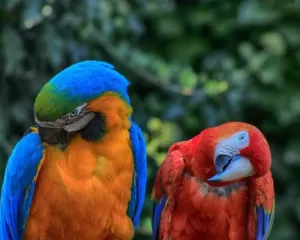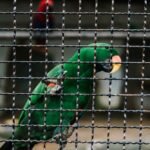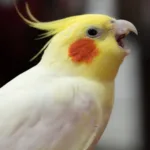The curious head tilt is a common behavior in most parrots. You may have seen your parrot tilting their head and looking with inquisitive eyes like they’re pondering on something. However, this adorable pose is more than just a behavioral quirk. Tilting the head sideways has several important functions for parrots.
Parrots tilt their heads to improve their vision and depth perception. Since their eyes are placed on the side of their heads, they naturally have poor binocular vision. Tilting the head can help them to look directly at the object in front of them or above them.
That being said, there are other less common reasons for head tilts in parrots. If your parrot is tilting its head more than usual, it can be related to a neurological condition. Parrots also like to stare at people with their heads rotated when they feel playful.
Quick Navigation
Reasons Why Parrots Tilt Their Heads
There are a number of different reasons why parrots turn their heads sideways. Most commonly they do this to improve their vision, but it also serves other functions.
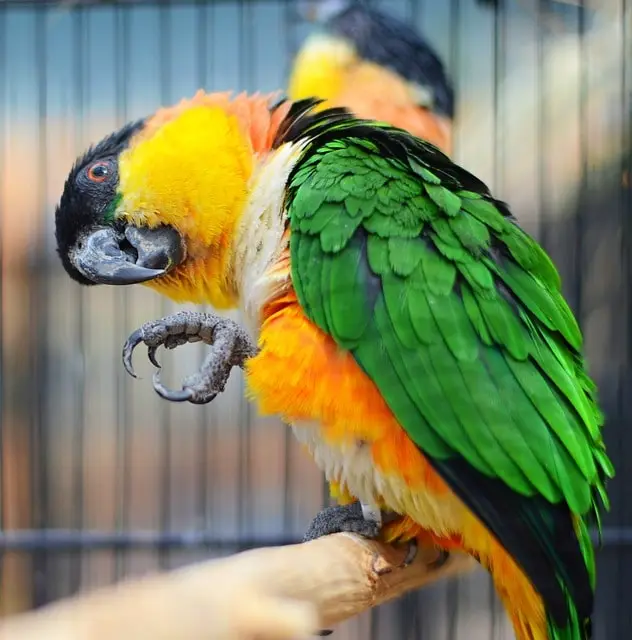
Increased Field Of Vision
Parrots, like many birds, have eyes located on the sides of their heads, which limits their binocular vision. They can scan a large area on both sides, but they cannot get a good view of the front without turning their head. Parrots often tilt their heads to increase their field of vision.
Research published in the Proceedings of the Royal Society B: Biological Sciences found that a parrot’s visual fields are distinct from those of other bird species, with a broad frontal view and an almost comprehensive field of view around the head.
Their beak provides them with tactile cues, so they don’t need to see what’s below their beaks as much as what’s above their heads. This is because they can find and explore things easily with their beaks.
Depth Perception
Parrots normally have a monocular vision, which reduces their three-dimensional perception. Tilting their heads allows them to adjust their visual field and potentially improve their depth perception.
By slightly adjusting their vision, it allows them to see an object from different angles and better understand its distance. They can perceive the three-dimensional space more accurately, which is helpful when they are trying to manipulate objects in their environment.
It particularly aids in daily tasks as it helps them assess distances and sizes more precisely. Parrots may tilt their heads while foraging for food, exploring their surroundings, or interacting with toys and other items. Parrots tilt their head sideways for a brief moment to get a better look at the object on the ground.
Lateralization
Brain lateralization results in the preference for using one side of the body, typically with the left side of the body being controlled by the right hemisphere of the brain and vice versa. Parrots with cerebral lateralization have a preference for one side of their body.
Most parrots are left-footed, which means they use the right side of their brain. A parrot with a preference for one side of its body will tilt its head in that direction. A parrot’s preference for a foot and its vision go hand in hand.
Scanning For Predators
Parrots do not have eyes at the back of their head, but they make up for it by being able to turn their head sideways. You may have noticed this when your parrot is facing opposite to you. As you walk up to your parrot from behind it turns its head to see.
It does not need to turn its whole body to look behind. This helps in keeping an eye out and escaping predators. Parrots have the ability to adeptly look behind them so they can take off efficiently in the opposite direction.
Better Hearing
Parrots can hear fairly well, which helps them look out for dangers nearby. However, they cannot hear very low or high frequencies. Tilting their heads allows them to place their ears directly toward the source of a sound, which may help in determining whether it poses any threat.
Playful Staring
When your parrot is staring at you with its head tilted, it’s more than just a cute pose for the camera. It may be that your parrot is interested in its surroundings. This can occur when the parrot sees new objects or whenever people are near.
It can also be when the parrot hears sounds but doesn’t know where they’re coming from. By tilting their heads, parrots try to focus on the object or people and be more attentive. This behavior reflects their ability to explore and engage with their environment.
Sometimes parrots turn their heads upside down and stare at an object. This often alarms parrot owners because it is not a common behavior. However, it is not something to worry about unless your parrot is doing it frequently. If your parrot constantly rotates its head, it can be a sign of a medical issue.
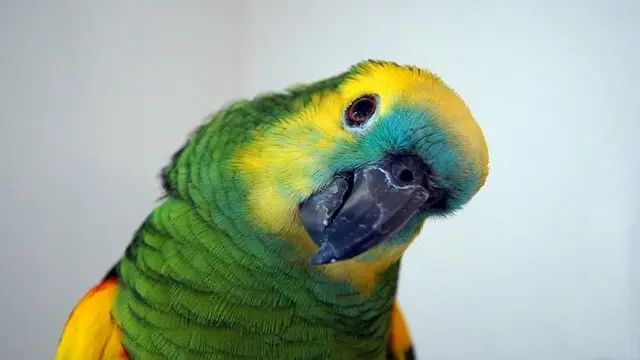
Torticollis
If your parrot’s head has become tilted to one side, it can be indicative of a medical problem. Torticollis, also known as wry neck is a condition in which the parrot’s head is tilted in one position.
This condition can occur due to various reasons such as injury, infection, vitamin deficiency, or even a neurological problem. According to VCA Animal Hospitals, a head tilt can be a sign of a neurological condition in parrots.
An article from BioOne details the case of a 23-year-old white cockatoo who had severe muscle wasting and acute ataxia and tilted its head to the right. The vets examined its condition but the results of the tests were not clear, and despite receiving supportive care and treatment, the bird passed away.
After examining the body, the vets found cysts in the muscles and heart, and they discovered some abnormal structures in the brain tissue that caused inflammation, which was caused by an infection.
